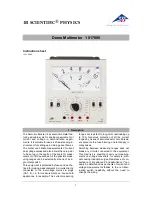
Generating SRQ on buffer full
When your program must wait until the Model 2002 has completed an operation, it is more
efficient to program the 2002 to assert the IEEE-488 SRQ line when it is finished, rather than
repeatedly serial polling the instrument. An IEEE-488 controller will typically address the in-
strument to talk, then unaddress it, each time it performs a serial poll. Repeated polling of the
Model 2002 will generally reduce its overall reading throughput. Therefore, use the
srq%()
function call.
The Model 2002 provides a status bit for nearly every operation it performs. It can be pro-
grammed to assert the IEEE-488 SRQ line whenever a status bit becomes true or false. The
IEEE-488 controller (your computer) can examine the state of the the SRQ line without per-
forming a serial poll, thereby detecting when the 2002 has completed its task without interrupt-
ing it in the process.
The following example program segment sets up the Model 2002 to assert SRQ when the
reading buffer has completely filled, then arms the reading buffer, initiates readings, and waits
for the Model 2002 to indicate that the buffer is full.
This is not a complete program. Not shown are the commands to configure the trigger model
and the reading buffer (see the next example). The example shown here can be modified for any
event in the Model 2002 status reporting system.
'Reset STATus subsystem (not affected by *RST)
CALL SEND(16, "stat:pres;*cls", status%)
CALL SEND(16, "stat:meas:enab 512", status%)'enable BFL
CALL SEND(16, "*sre 1"' status%)'enable MSB
CALL SEND(16, "trac:feed:cont next", status%)
' Start everything
CALL SEND(16, "init", status%)
WaitSRQ:
IF (NOT(srq%()) THEN GOTO WaitSRQ
CALL SPOLL(16, poll%, status%)
IF (poll% AND 64)=0 THEN GOTO WaitSRQ
Notice that after the program has detected an asserted SRQ line, it serial polls the Model 2002
to determine if it is the device requesting service. This is necessary for two reasons:
•
Serial polling the Model 2002 causes it to quit asserting the SRQ line.
•
In test systems that have more than one IEEE-488 instrument programmed to assert
SRQ, your program must determine which instrument is actually requesting service.
Once an event register has caused a service request, it cannot cause another service request
until you clear it by reading it (in this case using
STATus:MEASurement[:EVENt]?
) or by sending
the
*CLS
command.
IEEE-488 Bus Operation
3-23
Summary of Contents for 2002
Page 8: ...1 FrontPanel Operation...
Page 25: ...1 18 Front Panel Operation...
Page 26: ...2 Measurement Options...
Page 55: ...3 IEEE 488Bus Operation...
Page 84: ...4 Specsand Accessories...
















































